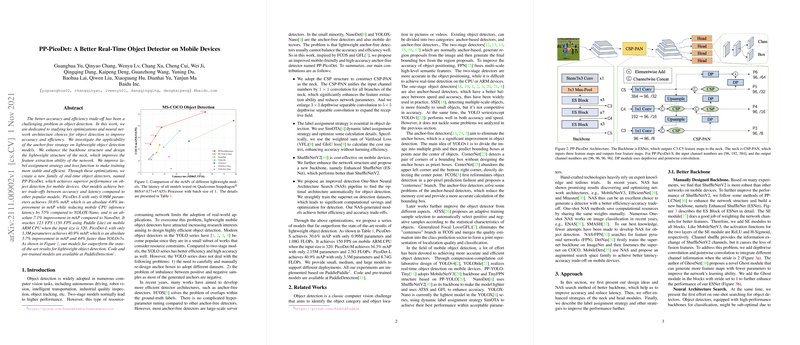Overview of PP-PicoDet: Enhancing Real-Time Object Detection on Mobile Devices
The paper presents the development of a new family of lightweight, anchor-free object detectors named PP-PicoDet, optimized specifically for mobile devices. Efficiency and accuracy are central concerns in object detection due to the constraints of mobile hardware. This research focuses on achieving a balance between these factors by refining neural architectures and leveraging novel strategies in object detection.
PP-PicoDet introduces several architectural enhancements and training methods that significantly outperform existing lightweight models in both accuracy and latency. Among various configurations, PicoDet-S and PicoDet-L exhibit substantial improvements over competitors such as YOLOX-Nano, YOLOv5s, and NanoDet, illustrating the potential of PP-PicoDet in mobile environments.
Key Contributions
- Architecture Enhancements:
- The paper adapts the CSP structure to create the CSP-PAN neck, optimizing feature extraction and reducing parameters while enhancing receptive field through depthwise separable convolutions.
- A novel backbone, Enhanced ShuffleNet (ESNet), is proposed, building on ShuffleNetV2 for better performance in mobile contexts.
- Training Strategies:
- The SimOTA dynamic label assignment strategy is utilized, refined with a modified cost matrix that employs a weighted combination of Varifocal Loss and GIoU Loss, which improves both accuracy and training stability.
- A one-shot NAS pipeline is developed that automates the search for optimal architectures directly on detection datasets, focusing on channel-wise optimization to achieve efficient architecture discovery.
- Performance Evaluation:
- PicoDet-S achieves a mean Average Precision (mAP) of 30.6% while significantly reducing CPU inference latency by 55% compared to YOLOX-Nano.
- PicoDet-L garners an mAP of 40.9%, with a 44% decrease in latency compared to YOLOv5s, demonstrating the notable edge of PP-PicoDet.
Implications and Future Directions
The research presents compelling evidence for the efficacy of optimized neural architectures and refined training methodologies in enhancing real-time object detection on mobile devices. Practically, these innovations facilitate high-performance applications in domains such as autonomous driving and intelligent transportation, where rapid, accurate detection is crucial.
Theoretically, PP-PicoDet highlights the potential of NAS and anchor-free methodologies in mobile settings, paving the way for further research into lightweight and efficient model designs. Future developments might explore more advanced NAS techniques or synergy between anchor-free strategies and emerging computer vision paradigms.
In conclusion, PP-PicoDet offers a significant advancement in mobile object detection, presenting a comprehensive framework that marries architectural efficiency with predictive accuracy. The exploration of novel strategies and their application to resource-constrained environments holds promise for future AI systems operating on mobile platforms.
